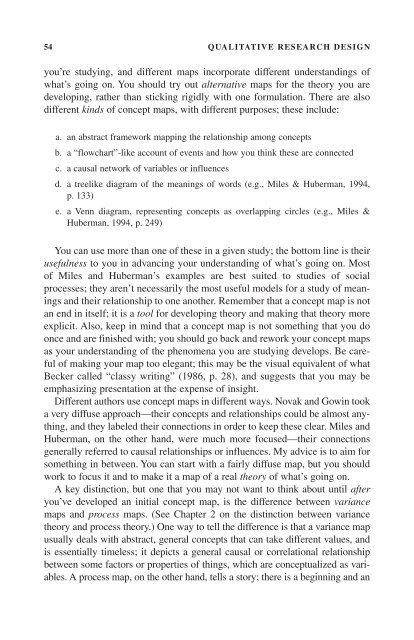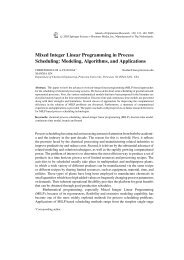Conceptual framework: What do you think is going on?
Conceptual framework: What do you think is going on?
Conceptual framework: What do you think is going on?
You also want an ePaper? Increase the reach of your titles
YUMPU automatically turns print PDFs into web optimized ePapers that Google loves.
03-Maxwell.qxd 10/1/2004 3:13 PM Page 54<br />
54 QUALITATIVE RESEARCH DESIGN<br />
<str<strong>on</strong>g>you</str<strong>on</strong>g>’re studying, and different maps incorporate different understandings of<br />
what’s <str<strong>on</strong>g>going</str<strong>on</strong>g> <strong>on</strong>. You should try out alternative maps for the theory <str<strong>on</strong>g>you</str<strong>on</strong>g> are<br />
developing, rather than sticking rigidly with <strong>on</strong>e formulati<strong>on</strong>. There are also<br />
different kinds of c<strong>on</strong>cept maps, with different purposes; these include:<br />
a. an abstract <str<strong>on</strong>g>framework</str<strong>on</strong>g> mapping the relati<strong>on</strong>ship am<strong>on</strong>g c<strong>on</strong>cepts<br />
b. a “flowchart”-like account of events and how <str<strong>on</strong>g>you</str<strong>on</strong>g> <str<strong>on</strong>g>think</str<strong>on</strong>g> these are c<strong>on</strong>nected<br />
c. a causal network of variables or influences<br />
d. a treelike diagram of the meanings of words (e.g., Miles & Huberman, 1994,<br />
p. 133)<br />
e. a Venn diagram, representing c<strong>on</strong>cepts as overlapping circles (e.g., Miles &<br />
Huberman, 1994, p. 249)<br />
You can use more than <strong>on</strong>e of these in a given study; the bottom line <str<strong>on</strong>g>is</str<strong>on</strong>g> their<br />
usefulness to <str<strong>on</strong>g>you</str<strong>on</strong>g> in advancing <str<strong>on</strong>g>you</str<strong>on</strong>g>r understanding of what’s <str<strong>on</strong>g>going</str<strong>on</strong>g> <strong>on</strong>. Most<br />
of Miles and Huberman’s examples are best suited to studies of social<br />
processes; they aren’t necessarily the most useful models for a study of meanings<br />
and their relati<strong>on</strong>ship to <strong>on</strong>e another. Remember that a c<strong>on</strong>cept map <str<strong>on</strong>g>is</str<strong>on</strong>g> not<br />
an end in itself; it <str<strong>on</strong>g>is</str<strong>on</strong>g> a tool for developing theory and making that theory more<br />
explicit. Also, keep in mind that a c<strong>on</strong>cept map <str<strong>on</strong>g>is</str<strong>on</strong>g> not something that <str<strong>on</strong>g>you</str<strong>on</strong>g> <str<strong>on</strong>g>do</str<strong>on</strong>g><br />
<strong>on</strong>ce and are fin<str<strong>on</strong>g>is</str<strong>on</strong>g>hed with; <str<strong>on</strong>g>you</str<strong>on</strong>g> should go back and rework <str<strong>on</strong>g>you</str<strong>on</strong>g>r c<strong>on</strong>cept maps<br />
as <str<strong>on</strong>g>you</str<strong>on</strong>g>r understanding of the phenomena <str<strong>on</strong>g>you</str<strong>on</strong>g> are studying develops. Be careful<br />
of making <str<strong>on</strong>g>you</str<strong>on</strong>g>r map too elegant; th<str<strong>on</strong>g>is</str<strong>on</strong>g> may be the v<str<strong>on</strong>g>is</str<strong>on</strong>g>ual equivalent of what<br />
Becker called “classy writing” (1986, p. 28), and suggests that <str<strong>on</strong>g>you</str<strong>on</strong>g> may be<br />
emphasizing presentati<strong>on</strong> at the expense of insight.<br />
Different authors use c<strong>on</strong>cept maps in different ways. Novak and Gowin took<br />
a very diffuse approach—their c<strong>on</strong>cepts and relati<strong>on</strong>ships could be almost anything,<br />
and they labeled their c<strong>on</strong>necti<strong>on</strong>s in order to keep these clear. Miles and<br />
Huberman, <strong>on</strong> the other hand, were much more focused—their c<strong>on</strong>necti<strong>on</strong>s<br />
generally referred to causal relati<strong>on</strong>ships or influences. My advice <str<strong>on</strong>g>is</str<strong>on</strong>g> to aim for<br />
something in between. You can start with a fairly diffuse map, but <str<strong>on</strong>g>you</str<strong>on</strong>g> should<br />
work to focus it and to make it a map of a real theory of what’s <str<strong>on</strong>g>going</str<strong>on</strong>g> <strong>on</strong>.<br />
A key d<str<strong>on</strong>g>is</str<strong>on</strong>g>tincti<strong>on</strong>, but <strong>on</strong>e that <str<strong>on</strong>g>you</str<strong>on</strong>g> may not want to <str<strong>on</strong>g>think</str<strong>on</strong>g> about until after<br />
<str<strong>on</strong>g>you</str<strong>on</strong>g>’ve developed an initial c<strong>on</strong>cept map, <str<strong>on</strong>g>is</str<strong>on</strong>g> the difference between variance<br />
maps and process maps. (See Chapter 2 <strong>on</strong> the d<str<strong>on</strong>g>is</str<strong>on</strong>g>tincti<strong>on</strong> between variance<br />
theory and process theory.) One way to tell the difference <str<strong>on</strong>g>is</str<strong>on</strong>g> that a variance map<br />
usually deals with abstract, general c<strong>on</strong>cepts that can take different values, and<br />
<str<strong>on</strong>g>is</str<strong>on</strong>g> essentially timeless; it depicts a general causal or correlati<strong>on</strong>al relati<strong>on</strong>ship<br />
between some factors or properties of things, which are c<strong>on</strong>ceptualized as variables.<br />
A process map, <strong>on</strong> the other hand, tells a story; there <str<strong>on</strong>g>is</str<strong>on</strong>g> a beginning and an
















